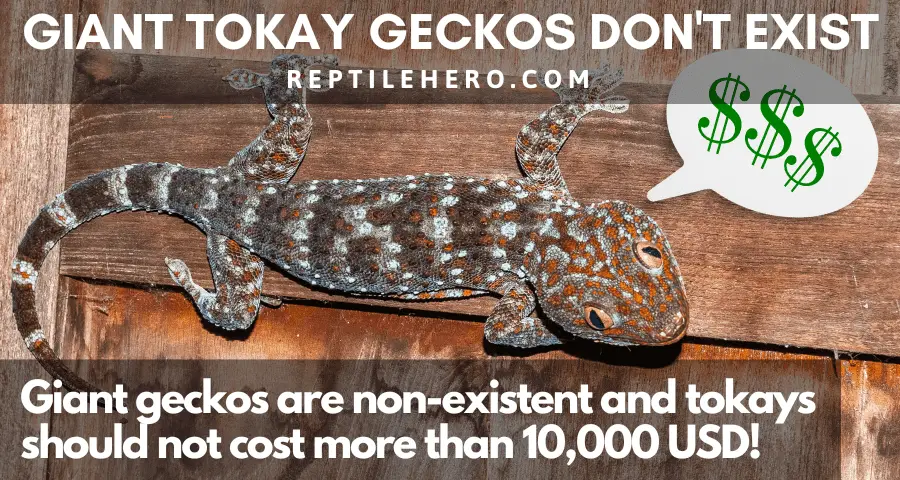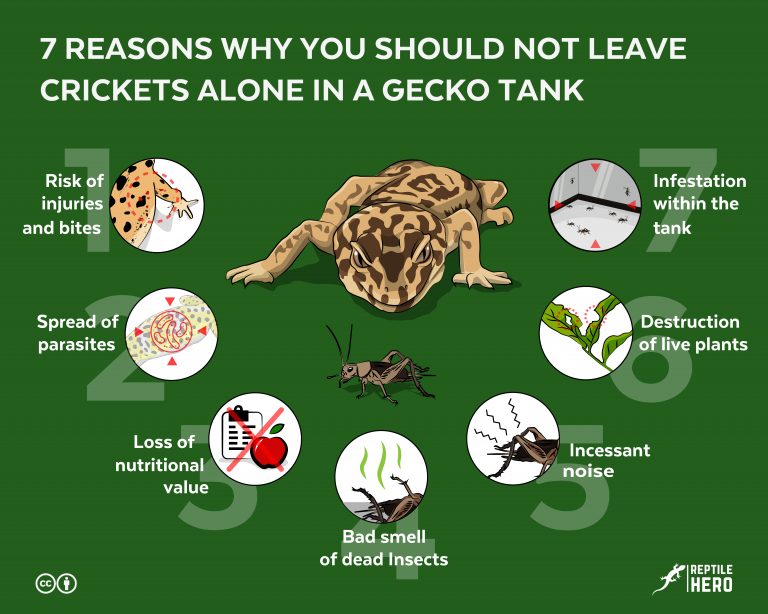Why are Tokay Geckos So Expensive? (3 Reasons!)
Did you know that tokay geckos are considered pests and invasive species in some states in America? Nevertheless, when you want to buy one as a pet it’s good to know whether they are expensive. This is also why more and more reptile owners are looking into getting tokays!
Tokay geckos can be very expensive because: 1) of the area they have been bred, 2) their availability, and 3) the rarity of the morphs being sold. Tokays priced below 50 USD are likely wild-caught and they are not recommended. A good quality captive-bred tokay gecko is likely to cost 200 USD or more.
Is it true that giant tokay geckos can cost one million bucks? Do those even really exist? Continue reading to find out the truth!
1. Source
Locally sourced and captive-bred tokay geckos are more expensive than legally and illegally imported wild-caught specimens. This is because breeding tokay geckos and guaranteeing a healthy animal is time-consuming. It also requires significant space and resources.
The common idea of imported goods being more pricey than domestic alternatives is really only applicable to food and clothing. You can’t expect the same for live animals like tokay geckos and other exotic reptiles in the pet trade. In fact, it’s the complete opposite for them.
If you’ve been part of the reptile community since the early 2000s, then you’d know that tokays back then were incredibly cheap. One adult gecko would easily cost only 10 bucks or even less, especially if you get them from a wholesale [1].
What was crazy during those times, however, was that buyers were typically expected to catch their picks by themselves!
Buyers would be taken to a large shipping container or the holding area where hundreds if not thousands of tokays are crammed together. Then, they’d have to personally get their hands on the tokay geckos of their choice, literally.
As fun and thrilling as such an experience might sound, the reality is incredibly disturbing. These poor wild animals were usually shipped and stored in facilities with poor conditions by the loads.
So if one was sick, then the disease could quickly spread and kill the rest. Most of them also have various injuries sustained during capture and from fights while being kept with many other stressed and territorial tokays.
Buying Wild-Caught Tokay Geckos is Highly Discouraged!
Nowadays, many wild-caught (WC) tokays still experience the same poor treatment. So every single one of us here at Reptile Hero is strongly against buying wild-caught animals.
More importantly, wild-caught geckos are oftentimes not in great condition.
Several beginner keepers who thought they could save a lot of money by buying dirt-cheap unhealthy wild-caught tokays, end up spending a fortune on medical bills in the long run!
Learn about the other risks in our article about why wild geckos shouldn't be kept as pets.
Furthermore, wild populations of tokay geckos in some parts of Asia have declined by as much as 50% due to unregulated capture and trade.
Tokays also became extremely expensive around the early 2010s because of scams and controversies. But that’s not exactly related to imported pet tokays. Nevertheless, I’ll talk more about this later so newbie keepers and pet parents are aware of potential scams!
2. Availability
Despite the growing popularity of tokay geckos, dedicated breeders are still considerably few. The increasing demand and limited supply make captive-bred geckos expensive.
Compared to other more common species like leopard and crested geckos, tokays are a lot less easy to find. Of course, big pet store chains will have thin and sick wild-caught tokays but you’d be hard-pressed to find captive-bred (CB) tokay geckos.
I mean, sure—there are tokay breeders and breeding groups in America. Compared to more docile geckos, however, the interest in producing big colonies of tokays is still very niche.
Even if you check reputable online markets and shops, you’d only find a couple of tokays available for sale at a time. You’d likely need to join a waitlist as well.
Now, to better understand why CB tokays are still not readily available, you need to consider what goes into breeding them. Growing a sizable captive-bred population of tokay geckos requires a lot of space, resources, time, and guts!
Unlike smaller lizards, tokay geckos have big heads and powerful jaws that make their bites strong, bloody, and painful—and no, this isn’t only true for wild tokays. So handling and taking care of them—which is necessary for pairing and breeding—isn’t as easy.
Discover the potential risks of owning one in our article on the dangers of geckos.
Considering how the demand for tokays has steadily been increasing in the last 5 years or so, it’s going to take a couple more years for there to be enough supply to go around. They are only going to become more affordable by then.
3. Morph
The rarity of a tokay gecko morph is directly correlated with its price. Rare morphs like the albino, platinum, super red, and yellow spotted, for instance, are significantly more expensive than tokays with normal wild-type colors.
To this day, there are only 2 known natural tokay gecko morphs. Black-spotted wild tokays are generally found in China and nearby areas, whereas red-spotted geckos are more commonly found around Southeast Asia [2].
Find out more about gecko genetics and coloration in our article on morphs!
However, thanks to all the time and effort dedicated breeders have put into breeding captive-bred tokay geckos, several striking morphs were produced.
Breeders and dealers from the UK and USA, in particular, are specializing in raising colonies of mesmerizing gecko morphs [3]. Relatively common morphs cost a few hundred bucks each but rare ones, like super red tokays, can set you back by thousands of dollars.
Below are some of the recognized tokay gecko morphs and some of their average prices in 2022:
- Albino—approx. 3,000 USD
- Blueberry
- Blue ghost
- Blue-headed green—approx. 450–850 USD
- Calico
- Candy button
- Caramel
- Granite—approx. 300–1,200 USD
- Green codominate—approx. 250 USD
- Green galaxy—approx. 350–600 USD
- Lavender
- Melanistic
- Normal (wild-type coloration)—approx. 70–250 USD
- Olive patternless—approx. 450–750 USD
- Orange-spotted melanistic
- Paradox—approx. 350–1,500 USD
- Parti-color
- Piebald
- Pinto
- Platinum
- Powder blue—approx. 600–1,000 USD
- Psychedelic
- Reduced pattern—approx. 200–500 USD
- Super red—approx. 2,000–3,000 USD
- Yellow-spotted—approx. 950–2,000 USD
Aside from these, there are still many unnamed morphs out there. Even now, numerous breeders are in the process of proving their traits to be inheritable through line-breeding which is an incredibly time-consuming process.
How Much Does a Tokay Gecko Cost?
The average cost of pet tokay geckos varies greatly. It has been found that wild-caught tokay geckos cost 15–65 USD. In comparison, captive-bred tokays with normal and common morphs cost about 70–200+ USD, while rare morph prices can be as high as 3,000 USD.
Keep in mind that different breeders sell their tokay geckos at different price points. So the price ranges I provided are just to give you a general idea of what to expect.
Also, these prices do not take shipping into account—you’d have to personally get in touch with the individual breeders to set that up properly.
If you go to chain pet shops, you’re likely going to find much cheaper “captive-bred” tokay geckos. Be very cautious and skeptical of these, especially if they are only priced at 50 bucks and less. It’s highly likely that they are just imported wild-caught tokays.
Conversely, you can’t guarantee expensive geckos are tame especially when their experience with handling and petting is very limited.
Expensive tokay geckos with rare morphs are not automatically easy to handle and tame. New owners need to establish a good relationship with them through proper handling.
Are captive-bred leopard geckos cheaper than tokay geckos?
Common leopard geckos are generally cheaper than tokay geckos, priced at more or less 100 USD each. Captive-bred tokays can cost twice as much at about 200 USD. However, prices for more rare morphs like black night leopard geckos and platinum tokay geckos are comparable, starting around 300–500 USD.
Tokay Gecko Controversies and Scams
In the early 2010s, serious controversies and scams surrounded the trade of tokay geckos. Mainly, these concerned their use in traditional Chinese medicine. However, scams in the pet trade also become prevalent during this time.
Before baseless claims about the miraculous effects of consuming geckos were widespread around the world, dried geckos were only worth a dollar or less [4]. These were usually either brewed into tonic teas or pulverized into powders before being capsuled.
Tokay geckos were considered and used as medicinal herbs, called Ge Jie, to soothe and treat a multitude of different illnesses and conditions since the 10th century. Such ailments include:
- Asthma
- Cancer
- Coughs
- Diabetes
- Eczema
- Impotence
- Tuberculosis
At the same time, live wild-caught tokay geckos were normally selling for only 20 bucks and much less. Despite being infamous for their aggressiveness and not being in demand, tokays were still commonly exported as exotic pets.
But around 2009, “giant geckos” became highly sought after because they were supposed effective in curing human immunodeficiency virus (HIV/AIDS) [5]. Other than that, they also had great potential as rare display pets.

Due to all of these, some buyers were willing to pay for non-existent “giant” tokays for as much as 10,000,000 dollars for a 1,000-gram gecko!
Regular adult tokay geckos were sold as “baby giant tokays” which buyers thought would grow massive and could be sold for a huge profit. Others also spent more than 6 grand for a single giant tokay only to receive a completely different animal altogether.
A few unlucky ones also ended up being robbed at gun-point with the scam used as a front and bait for interested individuals. There were also rare cases of kidnap-for-ransom.
Tokay Geckos: Fierce but Family-Oriented?
Captive-bred tokay geckos are also more expensive than other geckos because they form bonds with their mates which makes breeding them more selective and requires more resources. Tokay geckos tend to reject other potential mates with whom they have not been paired beforehand.
Never put your hands on a baby tokay gecko, especially if its parents are watching you closely!
One thing that people find truly fascinating about tokays is how they care for their hatchlings unlike most other gecko species [6]. They will be on guard and protect their offspring from others.
Hatchling tokays also closely learn and model their parents’ behavior, proving that they are—in fact—smart animals. But it’s best to separate young geckos from their parents before they mature to prevent possible aggression due to competition and lack of space.
Further Questions
Are there differences between male and female tokay gecko prices?
More often than not, male and female tokay geckos are sold at the same price points. However, this can differ depending on the breeders in the area. Sometimes, females may be more expensive as they are less available than males, and vice versa. The same can be said for unsexed tokays as well, though they generally sell at a lower price.
How do you tell apart male and female tokay geckos?
Tokay geckos don’t have pronounced hemipenal bulges for sex determination. Instead, owners can tell apart male from female tokay geckos by inspecting their overall size, femoral pores, and coloration. Male tokays have larger heads and bodies, more prominent pores that regularly excrete a waxy substance, and more vivid colors than females.
Is there any difference between buying a baby tokay or an adult one?
Adult tokay geckos are commonly more expensive than buying baby tokays because their coloration has fully developed and their sex can be better determined at that stage. Buyers no longer need to spend money for the initial care of an already adult tokay. However, it’s easier to tame baby tokay geckos if they are handled earlier on in their life.
How big can a tokay gecko get?
As the second largest gecko species in the world, tokay geckos can grow as long as 16 inches (40 cm) and weigh up to 400 grams (14 oz). Claims of giant geckos over 20 inches and 400 are widely recognized to be non-existent due to the lack of reports and evidence. Moreover, such claims are closely tied to scams.
What do tokay geckos eat?
Similar to most other gecko species, tokay geckos are primarily insectivores that require a varied diet of insects. However, as opportunistic feeders, wild tokays have also been documented to eat centipedes, spiders, and small animals including mice, frogs, snakes, and other lizards.
Are all tokay geckos aggressive?
Tokay geckos, by nature, are one of the most aggressive species of geckos but they can be tamed. Both captive-bred and wild-caught geckos can grow tolerant of handling and human interaction, in general, with frequent and proper handling. Keeping them in highly enriched tanks with up-to-date husbandry can also make them less aggressive.
Summary of Why are Tokay Geckos So Expensive
Compared to more commonly kept pet gecko species, tokay geckos are more expensive because: 1) it is harder to source captive-bred tokays, 2) not much supply of tokays is readily available, and 3) there still is no significant population of morphs.
Keepers and breeders can get captive-bred tokay geckos for more or less a minimum of 70 dollars and a maximum of approximately 3,000 dollars per gecko. Rare morphs are usually more expensive than common ones.
Though scams surrounding the pet trade of giant tokay geckos are less prevalent in recent years, it is still important to recognize them to avoid getting conned. Overpriced tokays are generally a good sign of a possible scam.
Sources
[1] http://herpconbio.org/Volume_6/Issue_3/Prestridge_etal_2011.pdf
[2] https://www.sciencedirect.com/science/article/pii/S2287884X15001041
[3] https://www.traffic.org/site/assets/files/7697/tokey-geckos-se-asia.pdf
[4] https://citeseerx.ist.psu.edu/viewdoc/download?doi=10.1.1.695.7931&rep=rep1&type=pdf
[6] https://reptilesmagazine.com/tokay-gecko-reproduction-breeding-and-genetics/

![How Fast Does A Gecko Decompose? [4 Factors]](https://www.reptilehero.com/wp-content/uploads/2021/04/How-long-does-it-take-gecko-to-decay-infographic-768x614.jpg)


![Why Is Your Gecko Staring? [At You, Other Animals, Other Objects]](https://www.reptilehero.com/wp-content/uploads/2022/01/why-gecko-stare-cc-768x614.jpg)
![3 Reasons Why Your Gecko Smells Bad [and 7 Tips]](https://www.reptilehero.com/wp-content/uploads/2021/04/G34_2-1-768x614.jpg)
![Is It Possible To Overfeed A Gecko? [4 Signs]](https://www.reptilehero.com/wp-content/uploads/2021/12/overfed-gecko-cc-768x614.jpg)
